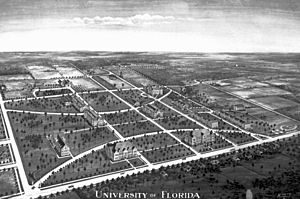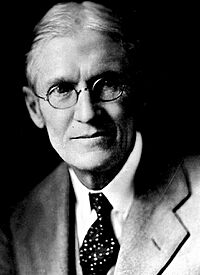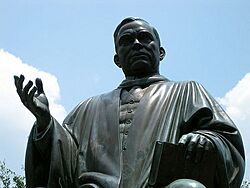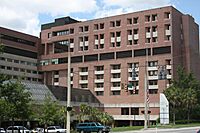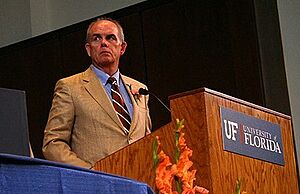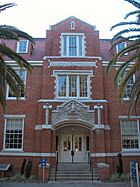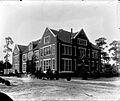History of the University of Florida facts for kids
The University of Florida has a long and interesting history, closely connected to how public education grew in Florida. The university started as several different schools that all came together to form one big state-supported university in 1905.
The oldest of these schools was the East Florida Seminary. It opened in Ocala in 1853, becoming the first state-supported college in Florida. Because it's the oldest part of what is now the University of Florida, the university traces its beginning back to that year. The East Florida Seminary closed during the American Civil War but reopened in Gainesville in 1866.
Another important school that became part of the University of Florida was the Florida Agricultural College. It was started in Lake City in 1884. This college was the first "land-grant" college in Florida, meaning it received land from the government to focus on teaching farming and mechanical skills. In 1903, the Florida Legislature changed its name to the "University of Florida" because they wanted the school to teach more than just agriculture.
In 1905, a law called the Buckman Act completely changed Florida's higher education system. Six state-supported schools were combined and reorganized into three schools, separated by race and gender. Four schools – the East Florida Seminary, the University of Florida at Lake City (which used to be Florida Agricultural College), the St. Petersburg Normal and Industrial School, and the South Florida Military College – were merged to create the new University of the State of Florida. This new school was for white males. At the same time, the legislature created the Florida Female College and the State Normal School for Colored Students, both in Tallahassee. These schools later became Florida State University and Florida A&M University.
Gainesville was chosen as the home for the new university, and construction on a new campus began there in late 1905.
The University of Florida grew a lot over the years. It started with 102 students in Gainesville in 1906 and grew to about 2,000 by 1930. By 1950, there were 10,000 students! The school started accepting some white women in 1924 and became fully coeducational (meaning both men and women could attend) after World War II, thanks to many new students joining through the GI Bill. It became racially integrated in 1958, allowing students of all races to attend. The university continued to grow and become more famous for its academics. It joined the Association of American Universities in 1985, and by 2000, over 50,000 students were enrolled. In 2021, it was named one of the top five public universities in the United States.

Contents
How the University of Florida Began (1823–1905)
Early Ideas for Colleges
In 1823, leaders in Florida and the United States Congress started planning a system for higher education in Florida. By 1836, Congress even approved setting up a "University of Florida." The first constitution for Florida in 1838 promised that colleges would be created. However, it wasn't until the 1850s that Florida's government actually started making these plans happen.
In 1851, the legislature decided to allow two seminaries (schools for higher learning) to be built, one on each side of the Suwannee River. These were the West Florida Seminary and the East Florida Seminary. On January 6, 1853, Florida's governor, Thomas Brown, signed the law that provided money for these schools. The East Florida Seminary in Ocala, Florida opened in the fall of 1853, becoming Florida's first state-supported college. The West Florida Seminary opened in Tallahassee in 1857.
The East Florida Seminary closed in 1861 when Florida left the U.S. at the start of the American Civil War. During and right after the war, higher education in the state almost stopped because there weren't enough students or money.
After the Civil War
East Florida Seminary Reopens
James Henry Roper, a teacher and state senator from Alachua County, had started Gainesville Academy in 1858, but it closed three years later. After the Civil War, the Academy's buildings were empty. Roper offered the property to the state as a new home for the East Florida Seminary. The state accepted, and the seminary reopened in Gainesville in 1866. Epworth Hall, the main building of the seminary's Gainesville campus, is still standing today near downtown.
Florida Agricultural College Starts
In 1884, Jordan Probst started what became the other main school that led to the University of Florida: Florida Agricultural College in Lake City. This college was Florida's first "land-grant college." Its main goal was to teach scientific farming and mechanical skills.
Early "Universities of Florida"
Florida's constitution from 1868 said that a state-sponsored university should be created. The state first tried to create a multi-college university in 1883 in Tallahassee. They combined the West Florida Seminary with another school to create "Florida University."
In 1903, the Florida Legislature gave the name "University of Florida" to Florida Agricultural College in Lake City. This was because the school wanted to teach more than just farming and engineering. It used that name for two years before all state-sponsored schools were completely reorganized by the Buckman Act.
The University of the State of Florida (1905–1909)
The Buckman Act
In 1905, Florida passed the Buckman Act. This law reorganized the state's university system. It combined six schools into three: one for African Americans, one for white women, and one for white men. Four schools – the University of Florida at Lake City, the East Florida Seminary in Gainesville, the St. Petersburg Normal and Industrial School, and the South Florida Military College – were merged to form the new University of the State of Florida.
This new University of the State of Florida was for white men. The State Normal School for Colored Students (which became Florida A&M University) was for African Americans. The Florida Female College (which became Florida State University) was for white women. There was also a fourth school for deaf and blind students.
Many cities wanted to be chosen as the home for the new university. Lake City and Gainesville were the top two choices. In July 1905, both cities sent groups to meet with the state Board of Control, who would decide where the school would go. Lake City offered its existing college campus. Gainesville offered over 500 acres of land, a new road, and free water service forever. On July 6, 1905, the Board of Control voted to put the new University of the State of Florida in Gainesville.
Starting in Gainesville
The buildings of the East Florida Seminary in Gainesville were not big enough for the new university while new buildings were being constructed. So, the Board of Control decided to use the old Florida Agricultural College campus in Lake City for the 1905–1906 school year. Andrew Sledd, who was president of the University of Florida at Lake City, became the first president of the new university. An architect named William A. Edwards was hired to design the first permanent buildings for the new Gainesville campus in a style called Collegiate Gothic.
The first year was a time of change. Classes were held in Lake City while supplies and people slowly moved to Gainesville. Lake City leaders were angry and tried to stop the move with lawsuits, but they didn't succeed. In the summer of 1906, the university tried to hire wagons to move the last supplies to the train station, but no one in Lake City would help. Wagons had to be brought from Gainesville. A crowd of angry Lake City residents watched as the last wagons left on July 23.
President Andrew Sledd helped design the new school's courses, opened the campus in Gainesville (with Buckman Hall and Thomas Hall being the first buildings), and started its athletic program. Classes officially began in Gainesville on September 26, 1906, with 102 students. However, some state leaders criticized Sledd for having high admission standards, which they felt limited the university's growth. To end the disagreement, Sledd resigned as president in 1909.
Growth and Change (1909–1945)
The Murphree Years
The school's name was shortened to the University of Florida in 1909. That same year, Albert A. Murphree became its second president. During his 18 years as president, Murphree helped create many of the university's colleges and schools, such as the College of Arts and Sciences, the College of Law, and the College of Engineering. Student enrollment grew from under 200 when he arrived to over 2,000 when he passed away in 1927.
Another important thing that happened during Murphree's time was the naming of the Florida Gators. The university had sports teams since 1906, but they didn't have a mascot at first. This changed in 1911 when a local seller designed and sold school flags with an alligator on them. The school colors, orange and blue, were chosen around the same time. They are believed to be a mix of the blue and white colors of the University of Florida at Lake City and the orange and black colors of the East Florida Seminary.
In 1924, the Florida Legislature allowed women who were at least 21 years old and had completed sixty college hours to enroll in programs at the university that weren't offered at the Florida State College for Women. Before this, women could only attend during the summer. Lassie Goodbread-Black became the first woman to enroll at the University of Florida in 1925. However, very few women attended the university until after World War II.
The Tigert Years
John J. Tigert became the university's third president in 1928. He brought many new ideas for improving academics, sports, and how the university was run. Tigert helped create the idea of athletic scholarships in the early 1930s, which is how many college athletes get financial help today. Under Tigert, UF also started the University of Florida Athletic Association to raise money and manage the university's sports programs. Their first big project was building a new football stadium, Florida Field. Two years later, Florida became a founding member of the new Southeastern Conference. Academically, the school awarded its first doctoral degrees and focused more on general education.
When the United States entered World War II in 1941, most students left to join the military. The university had just survived the tough times of the Great Depression. To stay open during the war, the university offered its campus, classrooms, and dorms to the U.S. Government to train aircrews for the U.S. Army Air Force.
After World War II (1946–1984)
When World War II ended, many veterans came back to Gainesville in 1946. The university was flooded with both returning and new students who were able to attend college thanks to their GI Bill of Rights benefits. By 1947, over 7,500 students were enrolled, which was more than three times the number of students in 1928.
Because the university couldn't handle all the new students in Florida, the state opened a branch of the University of Florida in Tallahassee. The next semester, the Florida Legislature made Florida State College for Women a coeducational school again and renamed it Florida State University. The University of Florida then began to accept female students into all its colleges and schools.
The J. Hillis Miller Health Science Center was started in 1956, and Shands at the University of Florida hospital opened two years later. The College of Medicine was also established. The university's campus and student population grew quickly in the 1950s. Under President J. Wayne Reitz, the university peacefully integrated, and African-American students were allowed to enroll in 1968.
Becoming a Top University (1985–Present)
In 1985, Florida became a member of the Association of American Universities (AAU). This is a group of sixty-two top research universities in the United States and Canada. Florida is one of thirty-four public universities in this group. In 2009, President Bernie Machen announced plans to slightly reduce the number of undergraduate students and increase resources for graduate education and research.
The University of Florida has continued to climb in the U.S. News & World Report college and university rankings. In 2001, Florida was called a Public Ivy, meaning it's a public university that offers a quality education similar to the Ivy League schools. In 2010, it was ranked second in "Best Buys of Education" by Kiplinger. U.S. News & World Report currently ranks the University of Florida among the top national universities.
In 2013, Florida Governor Rick Scott said he wanted the University of Florida to be among the top ten public universities. In 2017, the University of Florida became the first university in Florida to break into the top ten best public universities according to U.S. News. The university also received over $837 million for research in 2018. In 2017, university President Kent Fuchs announced a plan to hire 500 new professors to help the university become one of the top five public universities. Most of these new professors will be in STEM fields (Science, Technology, Engineering, and Math).
Historic Buildings
Many buildings at the University of Florida are historically important. The University of Florida Campus Historic District includes many buildings and covers about 650 acres. Two buildings outside this historic district, the Old WRUF Radio Station (now the university police station) and Norman Hall, are also listed on the historic register. The buildings listed on the U.S. National Register of Historic Places for their architecture or history include:
|
|
|
Images for kids
See also
- History of Florida
- History of Florida State University
- List of University of Florida alumni
- List of University of Florida buildings
- List of University of Florida faculty and administrators
- List of University of Florida presidents
- University of Florida Alumni Association
- University of Florida Athletic Association
- University of Florida Campus Historic District


